Level Up Your Content Workflow
Stop juggling spreadsheets and emails. This list of top 7 editorial workflow software solutions for 2025 will help you streamline your content production. Whether you're a small blog or a large publication, find the perfect tool to manage deadlines, improve collaboration, and boost content quality. Discover how these platforms can transform your team's efficiency and organization. From Trello to Adobe Workfront, explore the best options and choose the right fit.
1. Trello
Trello, a highly adaptable project management tool, leverages a Kanban-style approach to streamline content workflows. Its intuitive card-based system provides editorial teams with a clear visual representation of content progression through customizable workflow stages. This flexibility makes Trello suitable for a diverse range of users, from small content teams managing a blog to large publications juggling multiple content streams. Teams working in e-commerce, digital marketing, and even ad sales can also leverage Trello's power for project visualization and workflow management.
For instance, a publisher can create separate Trello boards for different magazines or websites. Within each board, lists represent various workflow stages, such as "Ideas," "Assigned," "Writing," "Editing," "Fact-Checking," "Design," "Ready for Publication," and "Published." Each content piece, whether an article, video, or social media post, is represented by a card within these lists. This granular approach facilitates tracking individual articles, managing assignments, and monitoring the overall content pipeline. As an article moves through the workflow, team members simply drag and drop the corresponding card to the next list, providing a real-time overview of content status and potential bottlenecks.
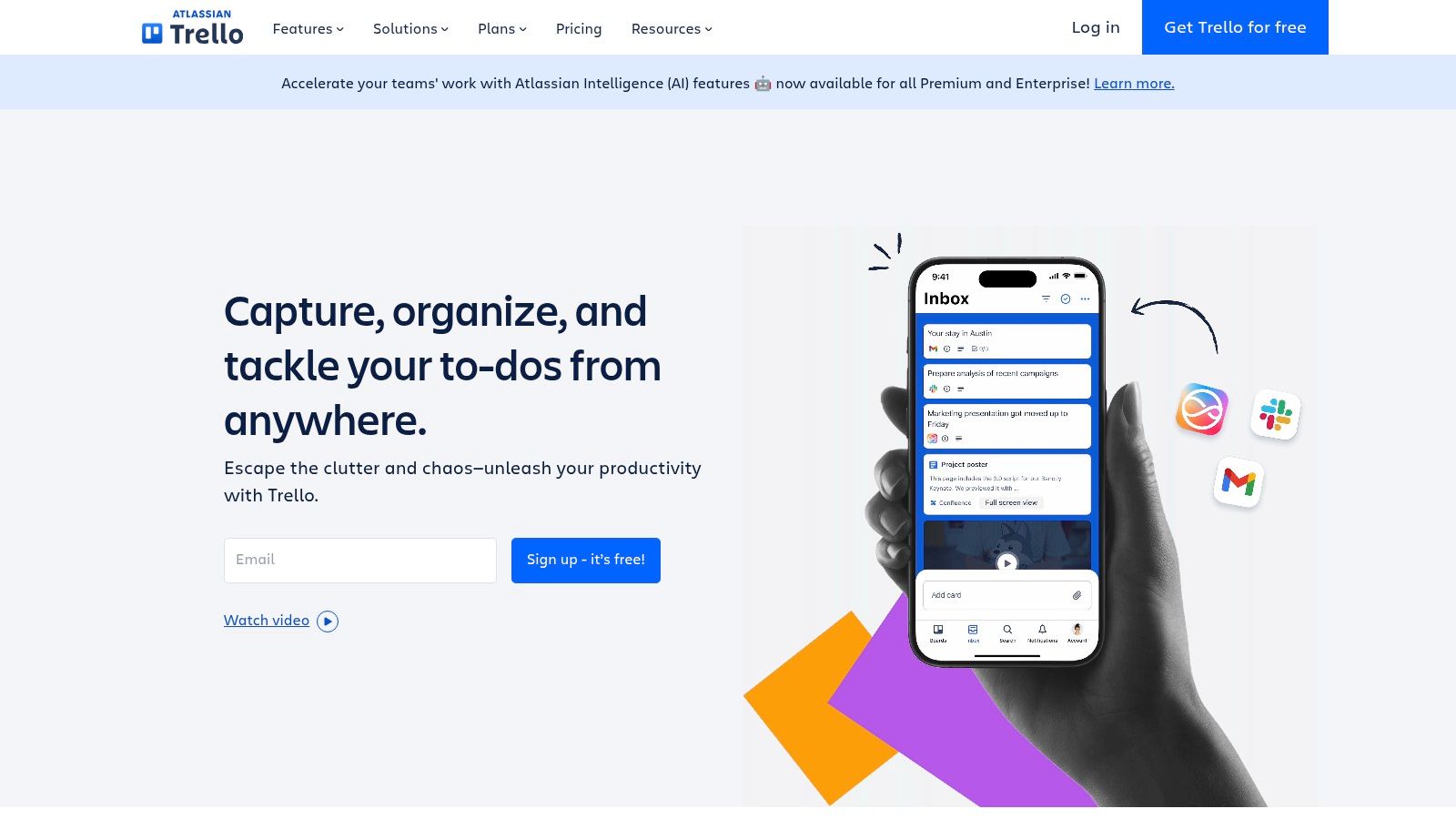
Trello's strength lies in its simplicity and visual clarity. Features like card attachments, checklists for subtasks (e.g., keyword research, image sourcing), due dates, and comments allow for detailed task management within each card. Its integration capabilities with over 200+ tools, including Slack, Google Drive, and Dropbox, further enhance workflow efficiency. For specific team needs, Trello's "Power-Ups" extend functionality – for example, integrating a calendar view or enabling advanced reporting features. Mobile apps for iOS and Android offer seamless access and management on the go, which is crucial for teams working across different locations or time zones.
While Trello's free tier offers substantial functionality for small teams, larger organizations may benefit from the Business Class or Enterprise plans for advanced features like unlimited boards, custom fields, and priority support. Pricing varies based on the chosen plan and the number of users. There are no specific technical requirements beyond a web browser or the mobile app.
Compared to dedicated editorial management systems, Trello's general-purpose nature may require some customization and integration with other tools to achieve a comprehensive editorial workflow. Tools like Asana offer similar project management functionalities, but Trello's visual Kanban board interface makes it arguably more intuitive for visualizing content pipelines.
Pros:
- Intuitive drag-and-drop interface requires minimal training.
- Free tier offers substantial functionality for small teams.
- Highly visual approach makes content status immediately apparent.
- Flexible system adaptable to various editorial workflows.
Cons:
- Can become cluttered with high-volume content production.
- Not specifically designed for editorial teams (lacks built-in editorial features like content versioning).
- Limited reporting capabilities without Premium upgrades.
- May require multiple integrations for a complete editorial system.
Website: https://trello.com
Trello earns its place on this list due to its accessibility, visual clarity, and flexibility. While not a full-fledged editorial management system, its adaptable framework and extensive integration capabilities make it a valuable tool for managing content workflows across various teams and publication sizes. To effectively implement Trello, start by clearly defining your workflow stages and creating corresponding lists. Use cards for individual content pieces and leverage attachments, checklists, and due dates to ensure comprehensive task management. Explore available Power-Ups to tailor the platform to your specific editorial needs.
2. Asana
Asana is a powerful work management platform well-suited for editorial teams of all sizes, though its robust feature set makes it particularly beneficial for larger teams and complex projects. It facilitates streamlined content production from initial brainstorming to final publication and distribution. Its flexibility lies in its multiple view options – lists, boards (Kanban style), timelines (Gantt charts), calendars, and workload – enabling teams to visualize their editorial calendar and workflow in a way that best suits their needs.
Imagine your team juggling multiple articles, blog posts, and social media updates simultaneously. Asana allows you to create individual tasks for each piece of content, assign them to specific team members, set deadlines, and track progress. Custom fields let you add content-specific metadata like word count, target audience, keywords, and associated campaigns, ensuring everyone has the necessary information at their fingertips. You can even link related tasks through dependencies, ensuring that one task (e.g., writing an article) is completed before another begins (e.g., creating accompanying social media posts).
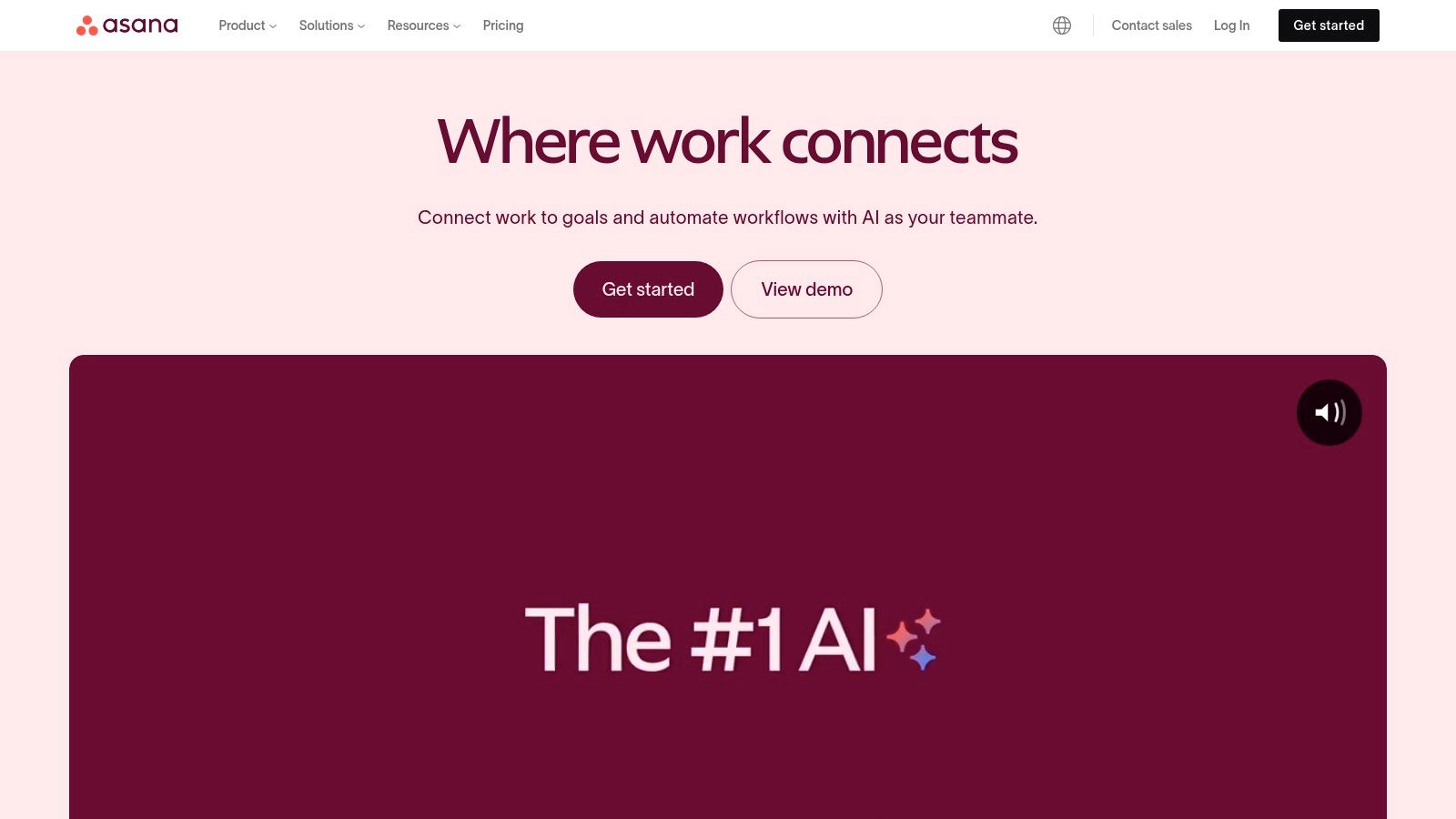
Asana's strength lies in its automation capabilities. Workflow rules can automate repetitive tasks, such as assigning tasks to editors based on content type or notifying team members when a task's status changes. This minimizes manual handoffs, reduces errors, and frees up time for more strategic work. For instance, when an article is marked "Ready for Edit," Asana can automatically assign it to the designated editor and notify them. The editorial calendar view provides a comprehensive overview of all planned content, allowing teams to effectively manage deadlines and avoid content gaps. Robust reporting and analytics features enable you to track content production metrics, identify bottlenecks, and optimize your workflow.
While Asana is a highly versatile tool, it's worth noting that it does have a steeper learning curve compared to simpler project management tools like Trello. The free version, while suitable for small teams of up to 15 users, has feature limitations. Larger teams requiring advanced features like custom fields, workflow automation, and advanced reporting will need to subscribe to a paid plan, which can be a significant investment. Additionally, the sheer number of features can feel overwhelming initially. Proper onboarding and training are essential for successful implementation.
Key Features: Multiple view options (list, board, calendar, timeline, and workload), Custom fields, Workflow automation rules, Dependencies functionality, Editorial calendar view, Reporting and analytics.
Pros: Comprehensive task management, Robust workflow automation, Multiple visualization options, Strong reporting and analytics.
Cons: Steeper learning curve, Limited free version, Can be overwhelming, Premium features can be costly.
Website: https://asana.com
Implementation Tips:
- Start small: Begin by using Asana for a specific project or team before rolling it out across the entire organization.
- Customize workflows: Tailor Asana to your specific editorial workflow by creating custom fields, automation rules, and project templates.
- Utilize templates: Asana offers pre-built templates for common editorial workflows, which can save you time during setup.
- Train your team: Provide adequate training to ensure your team understands how to use Asana effectively.
Asana earns its place on this list due to its comprehensive features designed specifically for managing complex editorial workflows. Its ability to automate tasks, visualize progress in multiple ways, and provide in-depth reporting makes it a valuable tool for optimizing content production and ensuring timely publication. While the initial investment in training and potentially a paid plan may be required, the long-term benefits in terms of efficiency and productivity make Asana a worthwhile consideration for serious editorial teams.
3. CoSchedule
CoSchedule distinguishes itself as a powerful editorial workflow software specifically designed for content marketing teams. It goes beyond basic project management by offering specialized tools tailored to the needs of content planning, creation, and promotion, making it a robust solution for organizations focused on content-driven strategies. This platform serves as a central hub, streamlining various aspects of content operations, from initial ideation to performance analysis. For teams juggling multiple content pieces, social media campaigns, and marketing initiatives, CoSchedule can bring much-needed order and efficiency. For instance, a marketing team preparing a product launch could use CoSchedule to coordinate blog posts, social media updates, email newsletters, and advertising campaigns, all within a single, integrated calendar. Learn more about CoSchedule to understand how a unified calendar helps streamline editorial efforts.
CoSchedule’s core strength lies in its integrated marketing calendar, providing a visual overview of all planned content activities. This bird’s-eye view enables teams to identify potential conflicts, gaps in their content schedule, and opportunities for cross-promotion. The platform’s task templates empower teams to standardize editorial workflows, ensuring consistency and reducing the likelihood of errors. Moreover, CoSchedule incorporates content optimization tools like a headline analyzer and SEO suggestions, directly supporting content quality and performance.
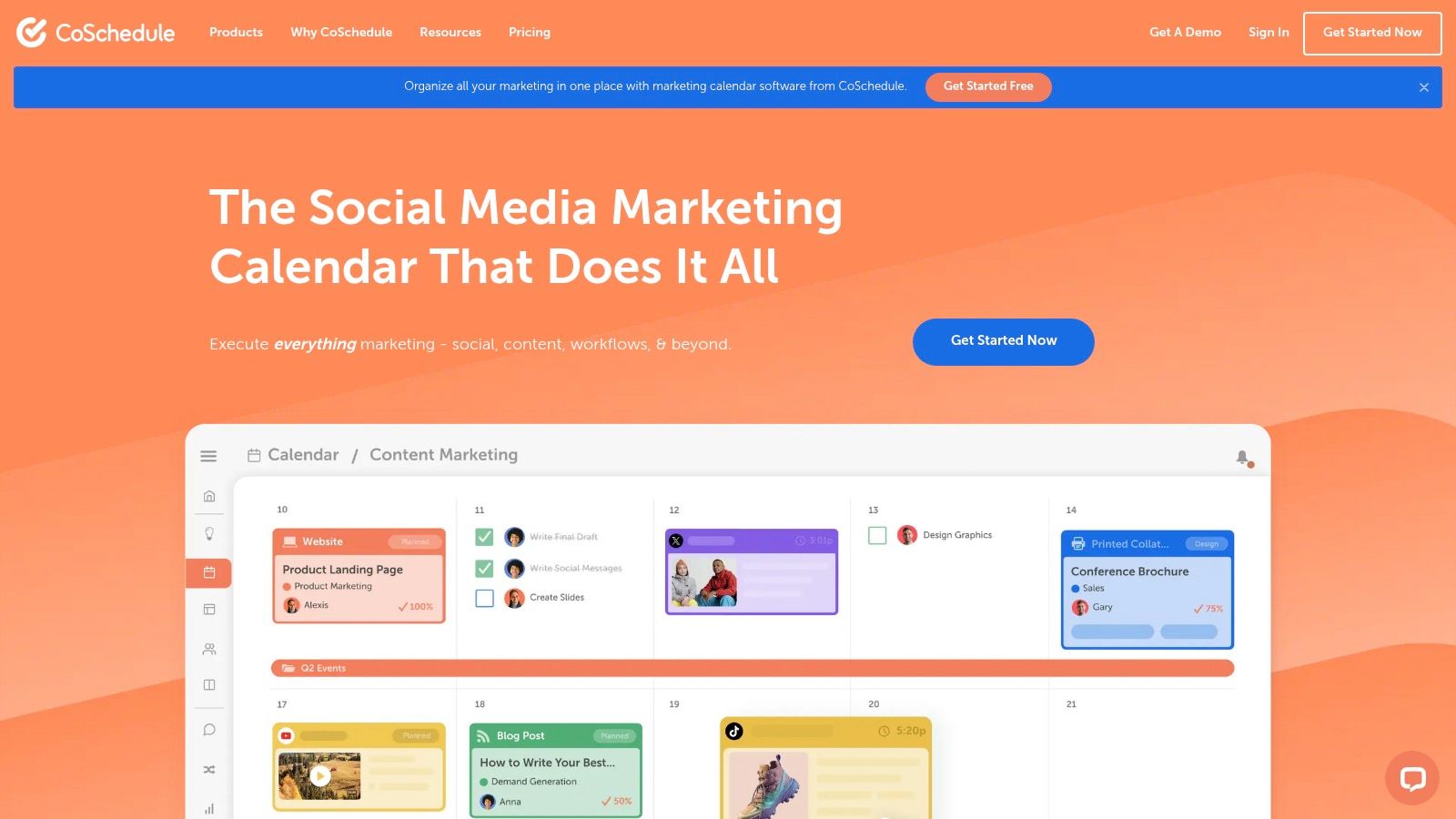
While pricing details aren't readily available on the public website, CoSchedule offers various plans catering to different team sizes and needs. You'll likely need to contact their sales team for specific pricing based on your requirements. Technical requirements are minimal, as the platform is cloud-based and accessible through a web browser. It boasts strong integrations with WordPress and other popular marketing tools, simplifying data exchange and streamlining workflows. For example, E-commerce teams can leverage the integration with their e-commerce platform to schedule product-focused content in alignment with sales promotions.
Pros:
- Purpose-built for content teams: Offers specialized features not typically found in generic project management software.
- Unified platform: Streamlines content planning, creation, and promotion within a single interface.
- Strong integrations: Connects seamlessly with popular tools like WordPress and various marketing platforms.
- Reusable workflow templates: Increases team efficiency and ensures consistency across projects.
Cons:
- Higher price point: Can be more expensive than general project management tools.
- Feature-rich: May have more functionality than required for smaller teams or simpler editorial operations.
- Limited customization: Enterprise-level customization options may be limited compared to some competitors.
- Tiered plans: Some advanced features require higher-tier subscription plans.
CoSchedule earns its spot on this list due to its comprehensive suite of tools specifically designed for content marketing teams. Its focus on content strategy, coupled with its integrated calendar and automation features, makes it a valuable asset for organizations looking to scale their content operations efficiently. You can explore more on their website: https://coschedule.com. One implementation tip: Start by mapping out your current editorial workflow and then customize CoSchedule's templates to match your specific processes. This will ensure a smooth transition and maximize the platform’s effectiveness.
4. Airtable
Airtable offers a unique approach to editorial workflow management, bridging the gap between the simplicity of spreadsheets and the robust functionality of databases. Imagine a spreadsheet that can handle rich content like images, videos, and long-form text, and then visualize that data in multiple ways like Kanban boards for task management or calendars for content scheduling. That’s the power Airtable brings to editorial teams. It allows them to build custom content databases tailored to their specific needs, moving beyond the limitations of generic project management software. Whether you're managing a blog, producing a magazine, or overseeing a complex content marketing campaign, Airtable can adapt to your requirements.
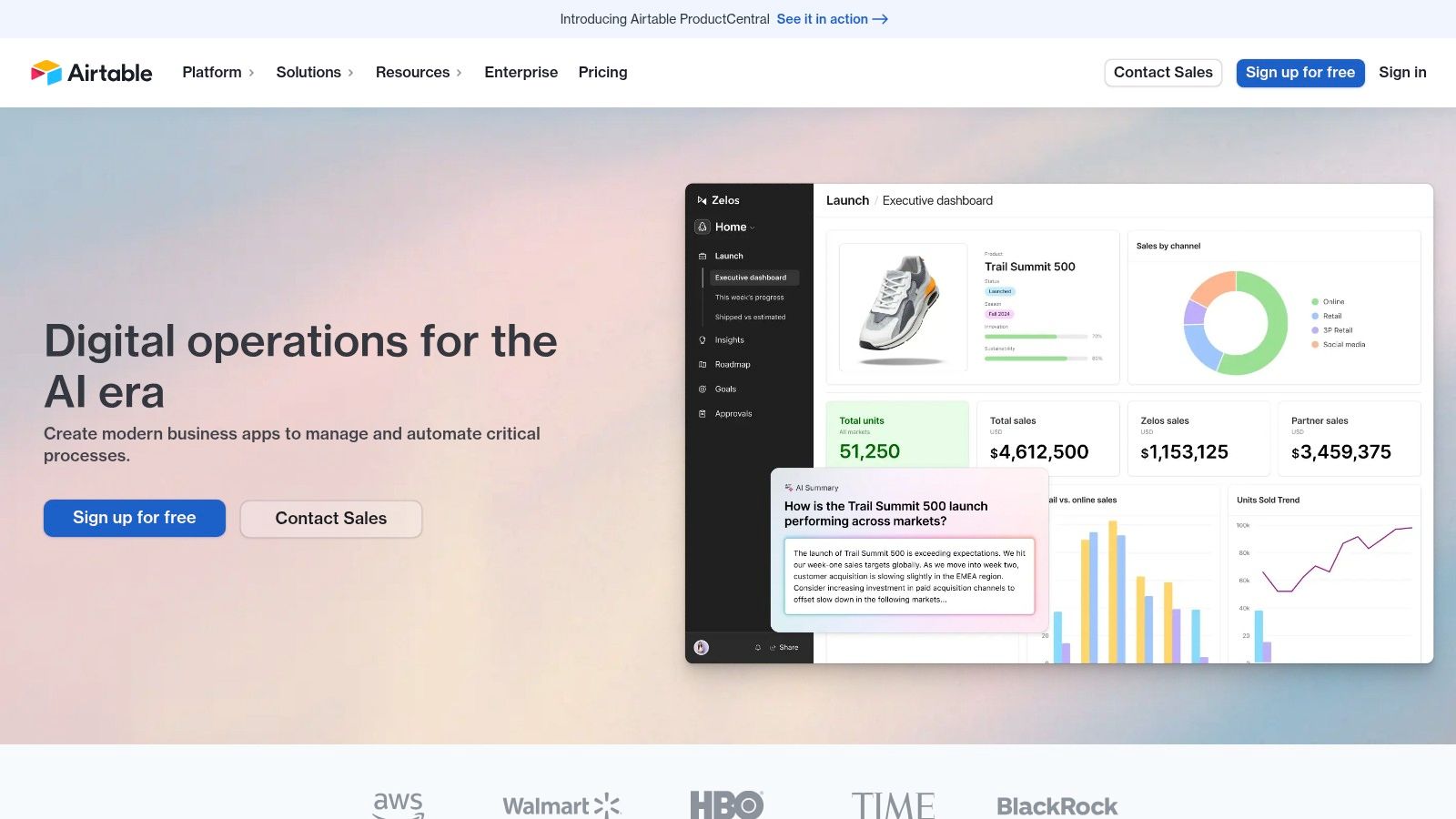
For example, a content marketing team can use Airtable to track every piece of content from ideation to publication. They can create fields for keywords, target audience, author, due date, publishing platform, and more. The relational database capabilities allow them to link articles to specific campaigns, authors, or topics, providing a holistic view of their content strategy. Editors can use the calendar view to visualize the publishing schedule, while writers can utilize the Kanban view to track their individual assignments. This level of flexibility and customization is why Airtable deserves its place in this list. Learn more about Airtable as a powerful DAM solution and its role in transforming business operations.
Airtable's versatility extends beyond content creation. Ad sales teams can leverage it to manage their inventory, track client campaigns, and monitor performance metrics. E-commerce teams can use it to organize product information, manage inventory, and track orders. The "Blocks" feature allows teams to visualize data in various ways, from charts and graphs to interactive maps and timelines, offering deeper insights into their editorial operations.
Features:
- Customizable database structure with 20+ field types: From attachments and checkboxes to dropdowns and formulas, Airtable provides the flexibility to structure your data precisely how you need it.
- Multiple view options (grid, calendar, kanban, form, gallery): Visualize your data in different ways to suit various tasks, from scheduling content to managing tasks and tracking progress.
- Relational data model to connect content with authors, topics, etc.: Link related information to gain a comprehensive understanding of your content ecosystem.
- Automations for workflow notifications and status updates: Streamline repetitive tasks and keep your team informed with automated notifications.
- Blocks feature for visualizing content data in various ways: Gain deeper insights into your data with interactive charts, graphs, and other visualizations.
Pros:
- Unmatched flexibility for custom editorial workflows: Adapt Airtable to any editorial process, regardless of complexity.
- Powerful filtering and sorting capabilities: Easily find the information you need with advanced filtering and sorting options.
- Extensible with integrations and API access: Connect Airtable with other tools in your tech stack to automate workflows and enhance functionality.
- Scales from simple to complex editorial operations: Whether you're a small team or a large organization, Airtable can grow with your needs.
Cons:
- Requires initial setup effort to create effective workflow systems: Investing time in planning and structuring your base is crucial for optimal performance.
- Free plan limited to 1,200 records and 2GB attachments per base: Larger teams or those with extensive content libraries may require a paid plan.
- Can be overwhelming for users unfamiliar with database concepts: The initial learning curve can be steep for users accustomed to simpler spreadsheet software.
- Advanced automation features only available on Pro+ plans: Some of the most powerful automation features are reserved for higher-tier plans.
Website: https://airtable.com
Airtable's pricing varies depending on the features and storage you need. They offer a free plan, as well as paid plans with increasing functionality and storage capacity. Check their website for the latest pricing information. There are no specific technical requirements beyond a web browser and an internet connection.
5. Monday.com
Monday.com is a versatile work operating system (WOS) well-suited for managing complex editorial workflows. Its strength lies in its highly visual approach, utilizing customizable boards, color-coding, and progress indicators to provide a clear overview of content status and deadlines. This makes it an excellent choice for publishers, media companies, content creation teams, and anyone working with a high volume of content. Imagine easily visualizing which articles are in drafting, editing, review, or ready for publishing, all within a single, intuitive interface.
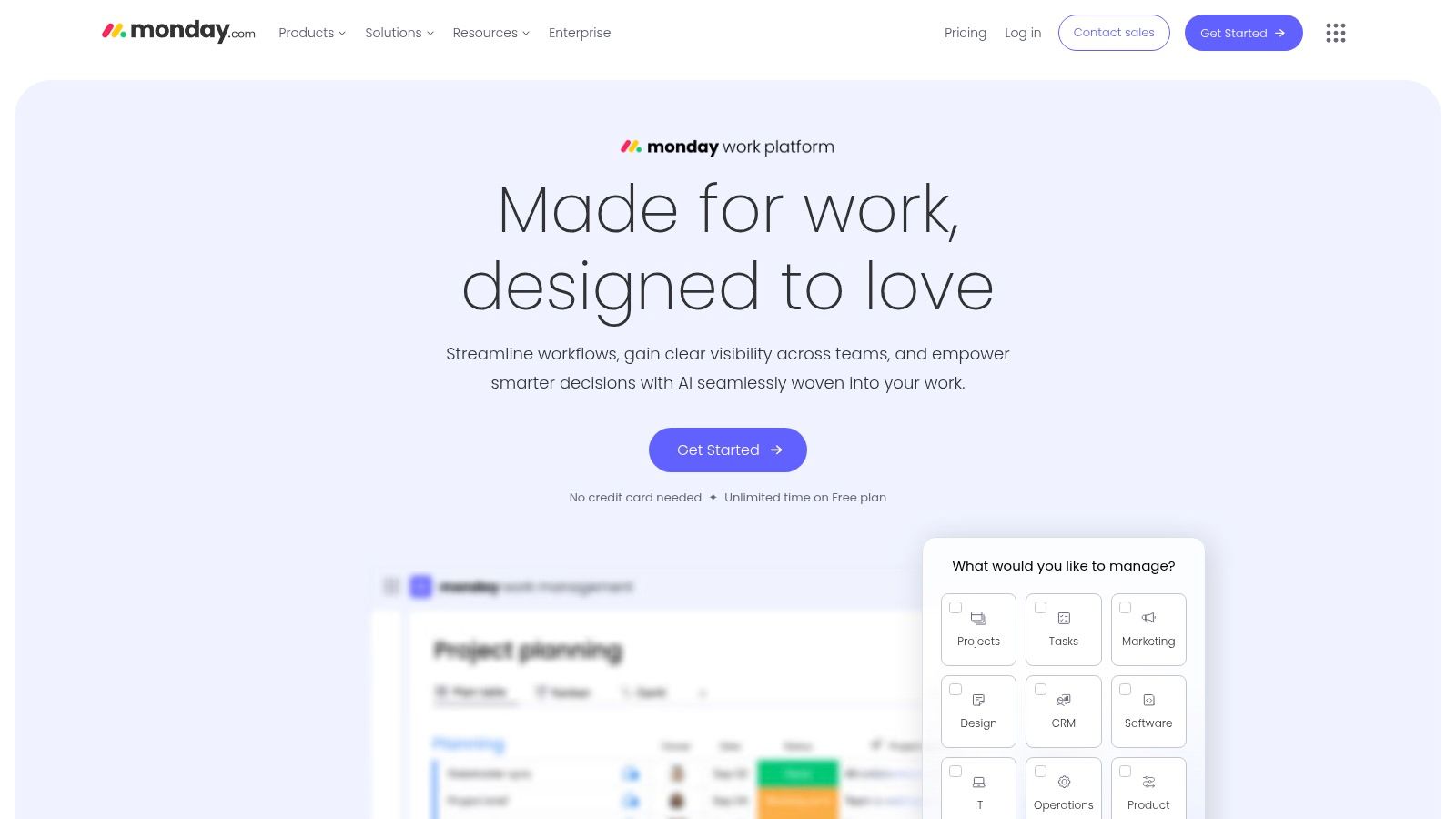
Specifically designed for content teams, Monday.com offers customizable workflow templates that can be adapted to your specific needs. For example, a blog editorial team can use a template to track blog posts from ideation to publication, while a social media team might track campaign development and scheduling. This flexibility extends further with customizable automation. Automate recurring tasks like assigning editors, sending reminders for deadlines, and even moving content through the workflow stages, freeing your team to focus on the creative process. Learn more about Monday.com and how it can specifically boost your content workflow management efficiency.
Monday.com shines with its powerful features, such as formula columns for automatically calculating content metrics like article length or social engagement, which can inform content strategy. The time-tracking feature helps manage writer and editor workloads, enabling efficient resource allocation. The embedded document viewer facilitates content review directly within the platform, streamlining feedback and revisions. This collaborative environment is particularly beneficial for remote teams.
While similar tools like Asana and Trello also offer project management functionalities, Monday.com distinguishes itself with its content calendar view tailored for publishers, giving a bird's-eye view of the publishing schedule. This feature, combined with its visual workflow management, makes it especially valuable for editorial teams juggling multiple content pieces simultaneously.
Pros:
- Highly visual interface: Improves workflow visibility and status tracking.
- Extensive template library: For quick implementation and customization.
- Robust automation capabilities: Reduces manual task management.
- Flexible views: Adapt to different roles in the editorial process.
Cons:
- Pricing: Can be expensive for growing teams.
- Feature limitations: Some features require higher-tier plans.
- Performance: Can have performance issues with very large boards.
- Mobile experience: Not as robust as the desktop version.
Implementation Tips:
- Start with a pre-built template and customize it to match your specific workflow.
- Utilize the automation features to streamline repetitive tasks.
- Integrate with other tools you're already using, such as Slack or Google Drive.
- Train your team on how to effectively use the platform to maximize its benefits.
Monday.com deserves its place on this list due to its powerful blend of visual workflow management, customizable features, and automation capabilities specifically designed for editorial teams. While pricing can be a consideration, the platform's ability to streamline content production, improve collaboration, and reduce manual work makes it a worthwhile investment for teams serious about optimizing their editorial processes. You can explore Monday.com and its features further on their website.
6. Notion
Notion is a versatile workspace that merges note-taking, project management, and wiki functionality into a single platform. For editorial teams, this means consolidating various tools and processes into one centralized hub. Imagine managing your editorial calendar, drafting articles, maintaining a style guide, and tracking progress all within a single, unified environment. That's the power Notion brings to the table. Its adaptable nature allows it to mold to your specific editorial workflow, whether you’re a small blog or a large publication.
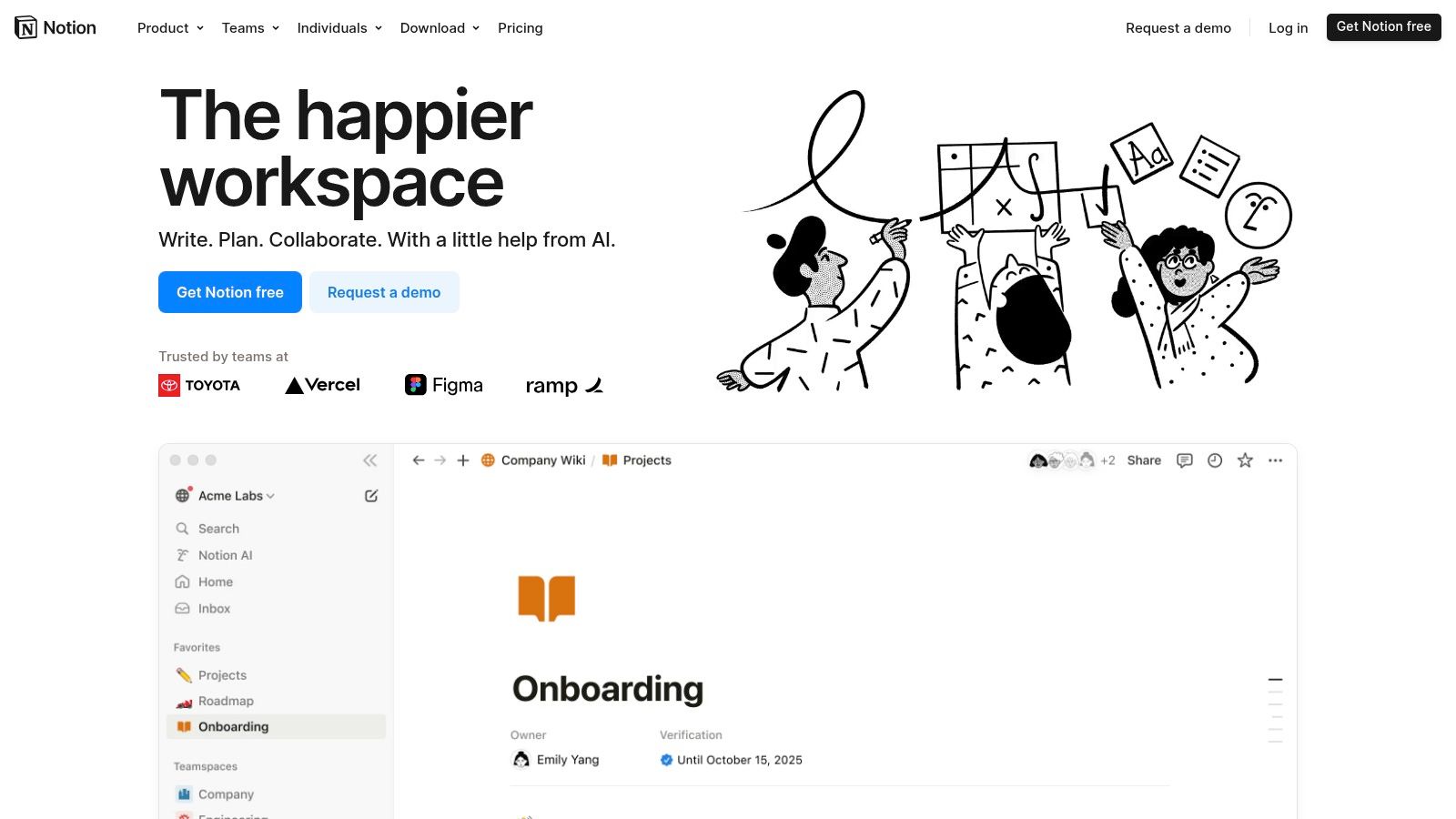
Notion’s core strength lies in its database functionality. Unlike simple document editors, Notion allows you to create databases of content, similar to Airtable, but with robust document editing capabilities within each entry. This allows you to create a content database that can be viewed as a calendar for scheduling, a Kanban board for progress tracking, a table for assigning tasks, or a list for brainstorming. For example, an editorial team could create a content database to manage articles, tracking each piece from ideation and drafting to editing, review, and publication. Each article entry can house the full article text, relevant images, SEO keywords, author information, and publishing date, all within the same database record.
For teams accustomed to separate tools for project management (like Asana or Trello) and content creation (like Google Docs), Notion offers a compelling alternative. Its all-in-one approach streamlines the editorial process, eliminating the need for constant tool switching and reducing the risk of information silos. It's particularly valuable for smaller teams and startups where budget and resources may be limited, as the free plan offers ample features for individual contributors.
Features:
- Combined document editor and database functionality
- Customizable databases with multiple view options (Table, Calendar, Kanban, List, Gallery)
- Templates for editorial calendars and content planning
- Wiki-like organization for style guides and team resources
- Collaborative editing features for content creation
- Strong search and organization functionality
Pros:
- All-in-one platform reduces tool switching and improves collaboration.
- Highly flexible and adaptable to different editorial processes.
- Powerful search and organization capabilities facilitate efficient content management.
- Generous free plan caters to individual contributors and small teams.
Cons:
- Less structured than dedicated project management tools, requiring upfront planning and setup.
- Initial setup to create an effective workflow system can require time and effort.
- Limited automation capabilities compared to specialized project management platforms.
- Performance can slow down with very large databases.
Pricing:
Notion offers a free plan with limitations on the number of blocks (elements within a page). Paid plans start from $8/month per user (billed annually) and offer increased features like unlimited blocks, team collaboration, and advanced permissions.
Technical Requirements:
Notion is a web-based application accessible from any modern browser. It also offers desktop and mobile apps for Windows, macOS, iOS, and Android.
Implementation Tips:
- Start with a template. Notion offers numerous pre-built templates for editorial calendars, content planning, and other editorial workflows. This can significantly reduce setup time and provide a good starting point.
- Clearly define your workflow. Before diving into Notion, map out your existing editorial process and identify the key stages and tasks. This will help you structure your Notion workspace effectively.
- Utilize database views strategically. Experiment with different database views (Table, Calendar, Kanban, List) to find the best way to visualize and manage your content.
- Regularly review and refine your system. Notion’s flexibility allows you to adapt your workflow as your needs evolve. Regularly evaluate your Notion setup and make adjustments to optimize efficiency.
Website: https://www.notion.so
Notion earns its place on this list because it offers a powerful, flexible, and affordable solution for editorial teams looking to consolidate their tools and streamline their workflow. While it requires some initial investment in setup, its adaptability and all-in-one nature make it a compelling choice for modern editorial teams.
7. Adobe Workfront
Adobe Workfront is a powerful enterprise work management platform specifically designed to streamline complex content production workflows. Its robust features make it a solid choice for large organizations, particularly those already invested in the Adobe ecosystem, managing high volumes of content, and requiring granular control over their editorial processes. Think large publishing houses, media conglomerates, or enterprise-level marketing departments. While it comes with a higher price tag and steeper learning curve than other tools on this list, its comprehensive capabilities justify its inclusion for teams needing enterprise-grade features.
Practical Applications & Use Cases:
- Managing complex editorial calendars: Workfront enables detailed planning and scheduling of content across multiple channels and formats, from blog posts and articles to video and interactive content.
- Streamlining content review and approval: Its built-in digital proofing tools allow stakeholders to collaborate on revisions, provide feedback, and track approvals within a centralized system. Imagine eliminating email chains and scattered feedback documents!
- Balancing team workloads: Workfront’s resource management features offer visibility into team capacity, enabling editors to assign tasks effectively and avoid bottlenecks. This is particularly beneficial for teams juggling multiple projects simultaneously.
- Automating repetitive tasks: Workfront allows automation of routine tasks like content routing and notifications, freeing up valuable time for editors to focus on higher-value activities.
- Integrating with Creative Cloud: For teams heavily reliant on Adobe Creative Cloud applications like InDesign or Photoshop, the seamless integration with Workfront significantly streamlines the content creation and review process. Designers can work directly within their familiar tools, and updates are reflected in Workfront automatically.
Features & Benefits:
- End-to-end work management from planning to publication
- Digital proofing tools for collaborative content review
- Resource management for balanced workloads
- Customizable approval processes and routing
- Integration with Adobe Creative Cloud
- Enterprise-grade security and compliance
- Comprehensive reporting and analytics
Pros:
- Robust security and compliance features essential for large organizations
- Powerful reporting and analytics to track content performance and identify areas for improvement
- Scalability to accommodate growing teams and complex workflows
- Unified platform for content creation, review, and publication, minimizing the need for multiple tools
Cons:
- Significant investment in both cost and implementation time - this isn't a quick plug-and-play solution.
- Steeper learning curve compared to simpler tools. Proper training and onboarding are crucial.
- Can be overly complex for smaller editorial teams with less demanding needs.
- Requires administrator support for customizations and complex configurations.
Pricing: Adobe Workfront's pricing is based on a tiered subscription model, with pricing varying based on the number of users and features required. Contact Adobe sales for specific pricing details.
Technical Requirements: Workfront is a cloud-based platform accessible through a web browser. System requirements are generally minimal, but a stable internet connection is essential.
Comparison with Similar Tools: Workfront competes with other enterprise work management platforms like Wrike and Asana. While those platforms offer robust project management capabilities, Workfront differentiates itself with its specialized features for content production and tight integration with the Adobe Creative Cloud suite.
Implementation/Setup Tips:
- Start with a clear understanding of your workflow requirements: Before implementing Workfront, map out your existing editorial processes and identify key pain points you want to address.
- Invest in training: Ensure your team receives adequate training to maximize the platform's potential and minimize frustration.
- Customize workflows incrementally: Don't try to implement every feature at once. Start with core functionalities and gradually customize workflows as needed.
- Leverage Adobe support resources: Utilize the available documentation, tutorials, and support channels to navigate the platform and address any challenges.
Website: https://www.adobe.com/products/workfront.html
Workfront earns its spot on this list by offering a comprehensive solution for organizations with sophisticated content creation workflows. If your team struggles with managing complex projects, streamlining reviews, or balancing workloads, and especially if you're heavily reliant on Adobe Creative Cloud, Workfront is worth serious consideration, despite the investment involved.
7 Editorial Workflow Tools: Essential Features Comparison
| Tool | Core Features ✨ | User Experience ★ | Value Proposition 💰 | Target Audience 👥 |
|---|---|---|---|---|
| Trello | Kanban boards, card system, 200+ integrations | Intuitive drag-and-drop, highly visual | Free tier available, cost-efficient for small teams | Small to large editorial teams |
| Asana | Multiple views, custom fields, workflow automation | Comprehensive; steeper learning curve | Robust feature set; premium plans for scaling | Medium to large teams needing detailed tracking |
| CoSchedule | Marketing calendar, content optimization, analytics | Focused on content marketing; unified | Tailored for content teams; higher pricing | Content and marketing teams |
| Airtable | Customizable database, multiple views, automations | Flexible but requires setup effort | Highly adaptable; free plan has record limits | Teams needing custom workflows and data linking |
| Monday.com | Visual boards, customizable templates, automation | Highly visual; extensive integrations | Premium pricing with rich functionality | Editorial teams seeking enhanced workflow tracking |
| Notion | All-in-one docs, wikis, databases, templates | Flexible yet less structured | Generous free plan; deep customization potential | Small teams or solo users looking for unified workspaces |
| Adobe Workfront | End-to-end management, digital proofing, Adobe integration | Enterprise-grade; steep learning curve | Significant investment for large-scale operations | Large organizations with complex editorial workflows |
Choosing the Right Editorial Workflow Software
Choosing the right editorial workflow software from the many options available, including popular platforms like Trello, Asana, CoSchedule, Airtable, Monday.com, Notion, and Adobe Workfront, can significantly impact your team's productivity and content quality. This article has explored several leading tools, each with its own strengths and weaknesses. Key takeaways include the importance of considering your team's size and budget, the complexity of your content workflows, and necessary integrations with other tools in your tech stack. Remember that some tools excel at visual project management (like Trello and Asana), while others offer more robust features for content calendars and marketing automation (like CoSchedule). Platforms like Airtable and Monday.com provide highly customizable databases for managing all aspects of your content, and Notion offers a flexible workspace for various team needs. For enterprise-level solutions with advanced functionalities, Adobe Workfront is a powerful contender.
Social media management is a crucial aspect of many editorial workflows. If your team uses LinkedIn, consider exploring resources like LinkedIn post scheduling tools to streamline your social media publishing process. Source: LinkedIn Post Scheduling from Twillie.
When implementing any new editorial workflow software, ensure you dedicate sufficient time for team training and onboarding. Start with a pilot project to test the platform's capabilities and gather feedback before fully integrating it into your workflow. By carefully evaluating your options and considering your specific needs, you can choose a platform that empowers your team to create, manage, and publish high-quality content efficiently.
Streamline your editorial workflow even further with a powerful content operations platform. Aeon offers robust features tailored for complex content workflows, helping you manage every stage of the content lifecycle with ease. Explore Aeon today and discover how it can elevate your team's content creation process.